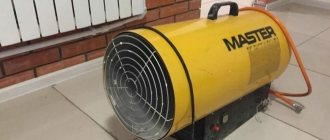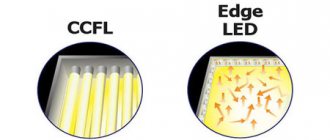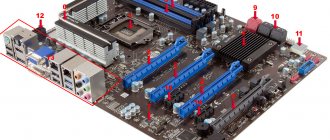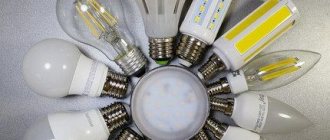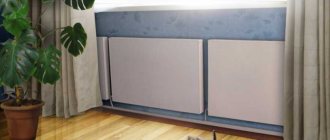Author: Website editors
Publication date: 29.04.2019
Issues discussed in the material:
- What common characteristics do different types of heat guns have?
- How can types of heat guns be classified?
- What are the differences between the types of diesel fuel heat guns?
- What features do electric heat guns have?
- Features of the operation of infrared heat guns
- Features of operation of water heat guns
- What are gas heat guns?
- What are multi-fuel heat guns
- Types of heat guns in a comparison table
- How to choose a heat gun
- How to calculate the power of a heat gun
To quickly heat up a room, you can use a powerful device called a heat gun. There are a great variety of these guns on the market, and their operating technology can be completely different. In this article we will talk about what types of heat guns there are and what differences there are between them.
What common characteristics do different types of heat guns have?
A heat gun is necessary when you need to efficiently and quickly heat various types of premises, for example, a trade pavilion, an exhibition hall, a retail space, a warehouse and other premises in which it is impossible or impractical to install stationary or other types of heating.
Obviously, maintaining the required temperature in any room is very important. This is necessary both for the comfortable work or residence of people, and, in the case of retail or warehouse premises, for the safety of goods.
Why is a heat gun called a gun? The answer is simple: this device is similar to a regular cannon and is made in a cylindrical shape. Special grilles are mounted in the metal body of the heat gun, through which outside air enters the gun and hits the heating element, after which it exits back into the room.
When we said that air is coming out of the heat gun, we were not entirely accurate. The air practically “shoots” out, since a fan system is installed inside the heat gun.
Thus, in a simplified manner, a heat gun can be called a fan that provides not cool, but warm air.
How can types of heat guns be classified?
Like any other complex device, a heat gun has differences according to which it can be classified as one type or another. You can start with the area of application of heat guns, the types of which we will now consider. So, heat guns are divided into:
- household;
- industrial.
In this case, the difference will be in the power of the heat gun. To heat an industrial premises, a high-power heat gun is needed, while a less powerful heat gun can cope with heating a home.
The types of heat guns can also be divided according to the type of fuel consumed for heating:
- electrical;
- water;
- diesel;
- gas;
- multi-fuel;
- infrared.
What are the differences between the types of diesel fuel heat guns?
The use of diesel fuel by this type of heat gun makes their operation somewhat costly. But there are also advantages: a diesel heat gun is mobile, does not have much weight, it is compact and easy to move. With all this, the type of diesel heat guns has good power.
Inside diesel heat guns there is a division based on the peculiarities of the mechanism of operation of the device. So, guns of this type come in direct and indirect heating.
Indirect heating heat guns are safer to operate, since the exhaust does not enter the room, but is discharged outside. Thus, only warm air enters when the indirect heating heat gun operates.
The operating time of a diesel fuel heat gun is limited by the size of its tank; accordingly, the larger the tank, the longer the operating time.
When choosing a heat gun of this type, it is important to take into account its consumption, which directly depends on the power of the gun itself. Diesel heat guns have a power ranging from 13 to 120 kW, respectively, and the flow rate will range from approximately 1 l/h to 6.3 l/h.
Direct heating heat guns, along with warm air, also emit combustion products of diesel fuel. This type is not used for heating rooms; these heat guns are used for drying materials: concrete, mortar, wood. This type of heat gun has a very high efficiency, and it is best to use them in a wide, open area so that the exhaust can dissipate.
If the heat gun has a chimney, then it can be used in rooms where people are constantly present. Many heat guns of this type are equipped with a special system for removing diesel combustion products. When they work indoors, the air is practically not polluted. However, oxygen is burned during operation, so the room must be well ventilated and ventilated.
Modern diesel heat guns are equipped with automatic equipment that monitors the heating temperature of the air, fuel supply and prevents the gun itself from overheating. Devices of this type do not require constant monitoring and can operate autonomously for a long time. If such a gun runs out of fuel or the fan turns off, the automation will turn it off itself. These systems also monitor the state of the flame in the gun.
Important : before connecting any type of heat gun, you need to carefully read its operating instructions.
The operation of the unit, which fully complies with its instructions, will be long and trouble-free, as well as safe. It is important to remember that a heat gun is not a battery, and drying things on it is strictly prohibited. Violation of this prohibition risks a fire.
What power should the gun be?
How to choose the right heat gun for your home based on power? Power affects the size of the room the device can heat and for how long. There are average power calculations for the heated area. Typically, for rooms with a ceiling height of 2.5 m, the following ratio of power and area is taken: 100 W of thermal power is required per 1 m2. For example, if you need to heat a garage of 15 m2, you need to choose a heat gun with a power of at least 1.5 kW.
If you need to warm up a box with high ceilings, then it is better to calculate the power based on the volume/power ratio: 2.5 m3 = 100 W. For example, you need to heat a box with an area of 30 m2 with a ceiling height of 4 m. Then you will need a device with a capacity of: 4 * 30 * 100 / 2.5 = 4.8 kW. So, you can take the Resanta TEPK-5000K with a power of 5 kW. You should not take power “for future use”, because the higher it is, the more expensive the device.
Which heat gun to choose for suspended ceilings? In order for the film to lay clearly on the ceiling without sagging or stretching, it is necessary to warm it evenly to 60° C. A device of 3 - 5 kW is suitable for a living room, bathroom or bedroom. For unheated new buildings, it is better to take a gun up to 10 kW.
What features do electric heat guns have?
Electric heat guns show increasing sales every year. Guns of this type are universal: they can be used in rooms with people, including residential ones, or installed in industrial premises.
An electric heat gun is more environmentally friendly than its diesel counterpart, because in the process of heating the air no exhaust gases are generated, which does not endanger the health of people near the device.
This heat gun operates on electricity, and it can be connected to a two- or three-phase circuit.
The heating element of this type of heat gun is a heating element or a spiral. The most common are guns with heating elements, since this heating element does not burn oxygen during operation and generally has a longer service life.
Electric heat guns are also equipped with a thermostat, which ensures that the device does not overheat. As soon as the air warms up to the required temperature, the thermostat turns off the power and the gun stops working.
In addition to keeping the gun itself from overheating, the thermostat prevents the air in the room from overheating, and also makes the electric heat gun economical.
When choosing a heat gun of this type, you need to find out whether your network meets the manufacturer’s declared parameters. It is prohibited to use the gun in conditions other than those specified in the instructions. You should also not use an electric heat gun in rooms with high humidity. To protect the device from dust, the gun is placed in a special case during storage.
Design and general characteristics
A diesel heat gun runs on combustible fuel - gasoline, diesel, diesel fuel, kerosene, etc., which makes its use on a regular basis costly. Some models consume less fuel without significant losses in performance, but they are also more expensive (for example, the Master diesel heat gun). Heat guns are divided into two types depending on the presence of a smoke exhaust system. Some models may require a power connection to operate, as... this is necessary for the operation of the fan and chimney (if the latter is present). Main components of a diesel gun:
- Burner. Releases a jet of flame that heats the air.
- The combustion chamber. Here the air is heated to high temperatures, heating the walls of the chamber.
- Motor. Required for the operation of some mechanisms. It runs either on fuel or on mains power.
- Nozzle for hot air outlet.
- Fan. Needed to create air circulation near the combustion chamber.
- Fuel pump (all liquid fuel devices have it in their design).
- Fuel tank.
- Fuel valve. Often works from the network.
Features to look for when purchasing:
- Heating power. The recommended value in kW is from 3 for home use, from 20 for large premises.
- Heating method.
- Air flow speed.
- Recommended fuel for use.
- Maximum heating area.
- Fuel consumption coefficient (kilogram of fuel per hour).
- Type of food. In most cases, it is recommended to choose 220 V.
Diesel heating guns have several significant differences from similar heat guns, the two most important of which are that they require flammable fuel to operate and there are strong differences in design, which can make repairs more or less expensive. Let's consider the advantages and disadvantages of a diesel heat gun for the average consumer.
Advantages
- Combustible heat guns are very productive. Warming up occurs quickly, after which the device releases warm air.
- Electricity consumption is kept to a minimum (in some models it is not required at all).
- Most models are compact, which allows them to be quickly folded and unfolded and transported.
- Easy to use. You just need to fill in the fuel and select the operating mode.
- Some models are equipped with a rheostat, which allows you to automatically stop the heat gun when the desired temperature is reached.
- Medium-sized rooms warm up almost instantly, larger ones within a few minutes.
- The gun can operate for a long time without refueling.
- During operation, the device does not heat above 35 degrees, which prevents overheating and undesirable fire.
- A heat gun is not dangerous to people if used correctly and if there is ventilation or a chimney.
We advise you to study - Wiring diagram for a double switch for two light bulbs
Flaws
- Diesel heat guns make too much noise when operating. However, in some places the operating noise is not so noticeable.
- Most modern heat gun models do not have a backup battery to power the motor and fan, so for normal and safe operation the device must be connected to an electrical outlet.
- It is necessary to control the amount of fuel in the tank and refuel on time.
- It is not recommended to come close to the hot air outlet, because Some models are unsafe and you can get a slight burn.
- High cost of maintenance, because it is necessary to regularly purchase fuel and lubricate some parts.
- Purchasing and repairing diesel heat guns is expensive.
Features of the operation of infrared heat guns
The main difference between heat guns of this type is that they do not have fans. The work is carried out by a special mechanism that uses infrared radiation to heat the air, and then distributes it in the room.
Air heating occurs due to heat transfer. An infrared heat gun does not heat the entire room, but only a certain zone, which is especially useful during construction or finishing work. It is with the help of a heat gun of this type that you can dry floors or walls after plastering.
Features of operation of water heat guns
As the name suggests, the operation of this type of heat gun requires the presence of water, which is poured into a special heat exchanger. During operation of the gun, the water heats up, after which the resulting heat is transferred to the environment.
The main advantage of heat guns of this type is their economy and efficiency - very little electricity is spent. In principle, a water heat gun is very similar to a battery with a fan. The latter is needed to distribute heat in the room.
Water heat guns are used in greenhouses or warehouses: heating of these structures is not fast, and a gun of this type is an excellent energy saver.
Heating type
Heat guns use one of several existing heating schemes. The heating type can be:
- Direct
- Indirect
- Directly heated heat guns are the simplest type of heaters that provide 100% efficiency. Direct heating involves the supply of hot air along with combustion products.
The main disadvantage of direct-heated guns is the saturation of the room being served with carbon monoxide . When operating a heat gun, the presence of people, animals, birds, etc. in the room is unacceptable.
In direct fired heat guns, the firebox is located in front of the fan. When the blade impeller rotates, the entire contents of the combustion chamber are blown outward, including smoke, soot, soot, etc.
The main advantages of direct heating are maximum heat transfer and high heating rate . At the same time, heat guns with direct heating have an order of magnitude more affordable price than their analogues with indirect heating.
- Heat guns with indirect heating are equipped with an insulated combustion chamber. Such heaters have a heat exchanger installed that transfers heat from the firebox to the surfaces blown by the fan.
Thanks to the insulated firebox, all combustion products are discharged to the street. A chimney is used for this. And environmentally friendly heat is supplied to the serviced premises.
Among the disadvantages of indirect heating, one can note the complicated design of the heat fan . Because of this, the cost of heat fans increases. Additionally, it is necessary to install a chimney system, which is quite difficult to implement in many facilities. We must not forget that indirect heating has much lower efficiency than direct heating.
The main advantage of heat fans with indirect heating is the ability for workers to be in a heated room . The advantages of this type of heat guns include the high economic profitability of heat production. Heating by burning fuel is much cheaper than using electricity alone.
What are gas heat guns?
A gas heat gun is used in approximately the same place and for the same purpose as a water heat gun - heating greenhouses and greenhouses in rural areas. This type of heat gun requires gas to operate, and the devices themselves can be mobile or stationary. Mobile heat guns use propane or butane cylinders, while stationary ones are connected to a gas main.
The efficiency of gas heat guns is comparable to water models.
Gas heat guns differ in the following:
- the air pumped into the gun by a fan is heated by the burner, after which it is released into the room, ensuring uniform heating;
- piezo ignition;
- 100% efficiency with a performance of no more than 140 kW;
- electricity is spent only on piezo ignition and fan operation, which indicates economical consumption - no more than 500 W;
- thermostat.
Compared to electric ones, gas heat guns are not as compact, but they do not require a powerful electrical network, and at the same time they are more economical. The maximum power of guns of this type is 140 kW. If you need to heat a room for a long time, then a gas heat gun is the best choice.
One of the key parameters when choosing a heat gun is its fuel consumption. Different gas models have different power, from 15 to 140 kW, respectively, and fuel consumption will be different - from 0.8 to 5.8 kg/h.
In order to connect a heat gun of this type to the gas main, you will need permission from the relevant authorities. But such permission is not needed if the gun is connected to a gas cylinder. However, a heat gun connected to a cylinder will consume an order of magnitude more fuel than one connected to the main line.
In order not to pose a threat to human health, rooms where a gas heat gun operates for a long time must be equipped with ventilation and regularly ventilated. Otherwise, it is dangerous to be in such rooms, since this type of heat gun burns oxygen during its operation. There is no need to worry about profitability, the efficiency of gas heat guns is very high (close to 100%), so small heat losses from ventilation will not lead to ruin.
Another factor influencing the safety of a gas heat gun is the ability to automatically control flame and overheating. When choosing models, preference should be given to those that have the above functions.
In addition to the above-mentioned advantages of gas models of heat guns: cost-effectiveness, simplicity and efficiency, they have another undeniable advantage - price. Gas heat guns are cheaper than electric or diesel counterparts.
Other characteristics
We have analyzed the main parameters: the rest do not seem so important. But if you want to approach your choice with full responsibility, then study them too.
Air flow
Shows how much air mass the device creates per hour. This characterizes the heating speed and depends on the fan.
Bandwidth should be looked at in conjunction with power. If the flow rate is high and the heating capacity is low, the outlet stream will be barely warm. There is no sense in such equipment.
This option is not available for infrared models.
Dimensions
Compact samples have low productivity. Be prepared to deal with bulkiness if you require a high-power unit. In general, weight ranges from 1 to 1500 kg.
Electric guns weigh 3-70 kg, and gas guns from 3 to 700 kg. The range of mass of liquid fuel specimens is enormous: from a modest 1 kg to 1.5 tons.
Shape and material
The body can be in the shape of a pipe or a rectangle. The first one resembles a real military weapon with its elongated cylindrical shape. It is capable of producing higher temperatures than its competitor. At the same time, rectangular devices provide more uniform heat distribution due to the increased dispersion zone.
All structures are made of metal. This is due to the danger of melting the plastic. In household models there are plastic inserts, for example, handles and switches. As a rule, they are hidden in such a way as to prevent them from becoming overheated.
Functions
Heat guns do not differ in their variety of functions. These are already quite expensive products and there is no point in complicating them with additional bells and whistles.
Increased attention is paid to ensuring safety. The devices are equipped with a switch-off option when tipping over. Liquid fuel and gas facilities are equipped with flame control: if it goes out, the fuel supply is stopped.
The thermostat helps control the heating level. As soon as the room temperature reaches the set value, the element stops working. Also, shutdown occurs if internal parts reach critical values. If you plan to leave the device unattended, then definitely buy a device with a thermostat.
Ventilation without heating allows you to mix the air in the room. And in hot weather, the device will replace your fan.
What are multi-fuel heat guns
As a rule, this type of heat gun operates on waste oil, both motor and hydraulic. The pump system in a multi-fuel heat gun delivers oil to the burner bowl, where it burns, releasing heat. During this process, the heat is transferred completely to the external environment, which brings the efficiency of this type of gun closer to 100%.
The multi-fuel gun, along with the gas gun, is the most effective. Models equipped with a thermostat can work 24 hours without interruption. Those guns that do not have this device work up to 15 hours a day.
Multi-fuel heat guns can be either directly heated or indirectly heated.
To avoid endangering public health, multi-fuel guns should be used in areas where people do not congregate and where there is good ventilation. Otherwise, there is a high risk of carbon monoxide poisoning.
Main design features
If a heat gun is required for heating, the choice must begin by taking into account the configuration of the unit housing. On the heating equipment market, manufacturers offer models of two forms:
- rectangular;
- tubular
They have their own characteristics and positive aspects.
The tubular variety has an oblong steel body, similar to a cylinder. A heating element is fixed deep in the body, which provides almost instantaneous access to the nominal temperature. And the tubular external unit allows for a directed flow of hot air.
The object warms up extremely quickly; a heat gun of this type is suitable for drying rooms. However, dust and dirt, when sticking to the coil, can become a prerequisite for the appearance of foreign odors and excessive oxygen consumption. Therefore, for residential buildings this kind of device will be irrelevant.
Each type of heat gun has its own characteristics
The rectangular device contains a heating element as a heating source, and it, in turn, is much safer than a heating coil. Heating is not as fast as it is in the tubular model, but at the same time it is more convenient and pleasant than from modifications with a tubular body. The device can be used in residential and office premises. The block is not so large and does not require much space.
It is worth paying attention to the structural components of the heat gun. If you buy it for stationary use, you should make sure that it has a stable stand - legs or foot.
In some cases, the device must be moved frequently. The steel body heats up during use, and in order not to burn yourself or harm others, you will need to hold the unit by the handle.
How to choose a heat gun
In general, the choice of a heat gun of one type or another is based on two important factors by which almost any equipment is selected. These are your financial capabilities and your requirements for a heat gun. And if the financial possibilities are usually more clear, then the desired qualities of the gun need to be clarified.
- Ask yourself, how often and how regularly will the heat gun be used? For some time in one season or is it planned to work constantly? It is also necessary to understand how much work the gun faces: heating the entire room or only part of it? Having decided on the answers to these questions, you can choose the type of heat gun.
- Another important question that needs to be answered in advance is what type of energy is most accessible? Knowing the answer to this question, you can decide on the type of fuel consumed by the heat gun and save a lot on it.
- Don't forget about safety. If you plan to operate a heat gun in crowded areas, then you need to choose a type that is safe in itself or is equipped with the necessary safety systems (for example, a gas exhaust system).
- It will also be useful to determine the power of the gun, so as not to overpay for its excess, or not to buy a device that will not cope with the task. It is generally accepted that for heating 10 square meters. m. of room you need to use at least 0.8 kW and no more than 1.4 kW of heat. It is also necessary to evaluate the speed of the blown air and the power of the fans in each specific type of heat gun.
These are general tips, now it’s worth taking a closer look at some of the key characteristics that differ between different types of heat guns.
- Power
Power is the main characteristic of any type of heat gun, and indeed all heating devices. The more powerful the heat gun, the faster it will heat the room.
When we talk about the power of heat guns, we mean their thermal power (the performance characteristic of the device), and not their electricity consumption. The last indicator is important only for electric heat guns. For gas types of these devices, as for liquid fuel types, electricity consumption is not so important, since it is needed not for the operation of the gun itself, but for the operation of fans and various types of automation. Typically, these types of heat guns consume tens to hundreds of watts.
Let's return to thermal power. This indicator for those types of heat guns that operate on liquid fuel can reach 220 kW. But such indicators are typical for direct-heating guns, while indirect-heating devices are much weaker, their power does not exceed hundreds or a little more than kilowatts. Gas heat guns usually have a maximum power of up to 150 kW, although some stationary types of these guns can be more powerful. Infrared guns have a maximum power of up to 50 kW.
As for electric heat guns, their varieties have a power of up to 50 kW, although some industrial devices can have twice as much power. Many types of them can heat the room in steps, depending on current needs. Electric heaters whose power does not exceed 5 kW are considered household, and more powerful ones are considered industrial. This division is due to the fact that household appliances can operate from a conventional electrical network with one phase and a voltage of 220 V, while more powerful industrial appliances require 380 V and a three-phase network. And this is a very important parameter that directly affects the choice of one or another type of heat gun. Before you buy a device, you need to make sure that the electrical network can handle its operation.
- Airflow
Heated air is supplied to the room by an electric fan inside the heat gun. Accordingly, the more efficient the fan, the faster the room will warm up. The efficiency of the fan is directly related to the power of the heat gun. In addition to the fact that a powerful fan will ensure quick heating of the air, it also protects the gun itself from overheating. From all this follows such a characteristic as air flow.
Air flow, or as it is also called - the performance of heating equipment - is the volume of air that the gun produces per hour of operation. The higher this indicator, the faster the room will heat up.
Note that infrared guns do not have fans and this parameter does not apply to them.
- Fuel type
For gas-fired heat guns, the fuel is:
- natural gas from the central pipeline;
- liquefied gas (butane or propane) in cylinders.
This type of fuel is cheaper than diesel, and, especially, electricity. Moreover, even bottled gas is cheaper, and even firewood cannot “outperform” the efficiency of main gas. From here we can draw a logical conclusion that if you need to heat large rooms, then you won’t find anything more cost-effective than a gas heat gun.
Liquid fuel heat guns can consume diesel fuel or kerosene. Moreover, manufacturers do not expand the list of possible types of fuel, limiting themselves to these two. Fueling heat guns with alcohol, naphtha, gasoline or any other flammable fuel is strictly prohibited. Ignoring this prohibition will result in fire, explosion and equipment failure.
It is also worth paying close attention to the quality of the fuel so as not to expose filters or injectors to increased wear. Low-quality fuel also harms spark plugs: carbon deposits form on them. The use of low-quality fuel serves as grounds for refusal of warranty repairs if the service department finds out that the heat gun broke down for this very reason.
There are also types of heat guns that operate on waste oil - engine, transmission, hydraulic oil and their mixtures. However, transformer oil and high-viscosity lubricants cannot be filled into such guns. Before filling the gun with any oil, it must be cleaned of mechanical impurities and water.
Infrared guns operate on liquid fuel, gas, and electricity. Their fuel quality requirements are the same as for liquid fuel types of heat guns.
In addition to the type of fuel and its availability, when choosing the type of heat gun, you should also take into account fuel consumption.
- Dimensions, mobility and weight
The weight and dimensions of a heat gun are proportional to its power and design. Small and lightweight devices are used for heating residential and office premises. Heavier, but also more powerful types of heat guns are used in industry and agriculture.
The lightest and most compact will be electric heat guns, whose weight does not exceed 30 kg. Accordingly, any such gun will also be mobile. This type of gun is almost ideal for household use - such guns do not emit harmful substances, are easy to use and, as you can see, light and compact.
Light weight and small dimensions are also typical for gas heat guns, but these devices cannot be called mobile. The reason is simple - gas guns are connected to a gas source, and if this source is a gas main, then it is not possible to move the gun to any place in the room.
Liquid fuel heat guns have significant weight and dimensions, since in addition to the gun, they are also equipped with a fuel tank and a combustion chamber. And if a gun of this type is indirectly heated, then it will be connected to the chimney, which reduces its mobility to zero. It is also worth saying that after refueling, the weight of the entire structure will increase according to the amount filled.
Liquid fuel heat guns can be very large and heavy, such that special equipment may be required to install and transport them. To operate such a device, you need to prepare in advance a strong and level platform that will support the weight of the heat gun.
It would be a mistake to assume that if the dimensions of the heat gun allow it to be indoors, then there will be no additional problems. This is not true - the heat gun must be located at a great distance from objects, especially if they are flammable and combustible materials. Also, the heat gun should not be located in places where people regularly walk. Therefore, for small rooms (narrow or small areas), it is better to choose a compact heat gun.
Gun selection criteria
The gun should also be selected based on its characteristics.
Thermal power and its calculation
How to compare several different devices in terms of performance? How do you understand that one device is designed to heat small garages, while another can easily warm up a huge warehouse? You need to look at the power indicator, and we are not talking about the electrical power consumed, or rather not always about it. This parameter will be indicative only for electric models. So let's start with them.
The power of electric guns ranges from 1 to 50 kW. It’s difficult to call 1-3 kW models “guns” - they’re more like fan heaters. Let us repeat that devices with a power of up to 5 kW can be connected to a 220 V network. Anything larger is equipment that requires a 380 V network. The most powerful electric guns are devices up to 100 kW.
The power of gas appliances ranges from 10 to 150 kW, but more powerful devices are often found. Diesel and multi-fuel direct heating devices produce all 220 kW, but their indirect heating counterparts have less power - a maximum of 100 kW. Infrared guns are rarely more powerful than 50 kW.
How do you know how much power is needed? Many people advise using an approximate calculation method, according to which 1-1.3 kW of power is sufficient for 1 m2 of space. If the room is low and well insulated, you can multiply by 1 kW, and if there are problems with thermal insulation, then it is better to take the coefficient with a margin.
If you want to get a more accurate result, then arm yourself with a calculator and the following calculation procedure:
- calculate the volume of the room , since this parameter is much more important than the area parameter. If you take a room with an area of 90 m2 and imagine that the ceiling height in it is 4 m, then the volume will be 360 m3;
- temperature difference between the desired indicator indoors (for example, +180C) and the indicator outside the walls. The weather outside in winter can be different. It is usually recommended to take into account the average winter temperature, making allowances for possible frosts. If the gun is the main source of heat, then it is better to take into account the lowest winter temperature. If you are making calculations for a residential building, then choose the comfortable internal temperature yourself. For warehouses, the accepted temperature is +120C, for public buildings - +180C.
- So, let’s say that in winter there are often frosts down to -200C outside, but inside you need to maintain the temperature at +180C, then the difference will be 380C;
- thermal insulation of the room plays an important role. A special coefficient is taken into account when calculating the power of the gun. If all walls, floor and roof are insulated, the number of windows is small, they have double frames, then k = 0.6-1. If the walls are brick, but without insulation, the roof is standard, and the number of windows is average, then k = 1-2. For structures with a single brick wall and single window frames (garages, for example), the coefficient k = 2-3 is used. For open and semi-open areas, simplified wooden and metal structures without thermal insulation, k = 3-4. Let's say we have a garage with double brick walls without thermal insulation, into which visitors will more or less often enter, then we will assume that k = 1.8;
- Thermal power is calculated using the formula Q = k*V*T. Then we get Q = 1.8*360*38 = 24,624 kcal/h, and since there are 860 kcal/h in 1 kW, it turns out that Q = 24624/860 = 28.6 kW;
- if the gun is not the only source of heat in the room, then this must be taken into account and the power of the existing equipment must be subtracted from the final result;
- You can take more than one high-power gun, but several smaller ones, in order to ultimately obtain the necessary power. If the room has a complex configuration, then several less powerful guns are even better than one more powerful one.
Heat gun dimensions
The higher the power of the gun, the larger it will be, which is not surprising. The most compact and mobile are electrical appliances. Household ones weigh from 3 to 5-7 kg, and some industrial ones reach 30 kg. Thanks to the wheels and handle, such devices can be easily moved; the only limitation will be the length of the wire.
Gas guns are also relatively compact and lightweight, and if the fuel source for them is bottled gas, then mobility will be fine. If you use main gas, then any gun will become stationary for some time.
Diesel and multi-fuel guns are considered the largest, since they also have a fuel tank. When it is completely filled with liquid fuel, the weight of the device increases. It is not easy to move a heavy liquid fuel gun, and if a unit with indirect heating is selected, then it is impossible to move the device at all, because it is connected to the chimney.
In special cases, giant heat guns are used, the weight of which amounts to tons. Naturally, such equipment is placed permanently, since even its transportation requires special transport. Mainly used on production sites.
Other technical characteristics
To assess whether this or that equipment is suitable for you, you need to analyze a number of additional parameters:
- air flow value, m3/hour. The indicator indicates how well the fan works. Ideally, it should be powerful enough to quickly warm the air around it and prevent overheating of the air directly around the gun. The amount of air flow is the volume of warm air that the device can generate in 1 hour of operation. The higher the power of the gun, the greater the air flow. The indicator ranges from 100-150 to 800 or more m3/hour;
- length of the air stream, m. This indicator also depends on the power of the fan and makes it clear how far the device can send an air stream;
- fuel consumption, kg/h or l/h helps to evaluate the efficiency of the device. It makes sense to compare the parameter with the same power of samples;
- operation noise, dB. All guns that operate thanks to a fan are noisy. The higher the power, the higher the noise level. If compact electric guns produce only 40-50 dB, then large gas and diesel ones can produce 80-90 dB, which will be disturbing in a small room. If noise level is a critical indicator, then it is better to leave the choice on the infrared model;
- duration of work. If the gun is the only source of heat, then it is important that it can work almost around the clock. In the model description you can see something like this 24/1 or 24/2. This means that the device can rest for 1-2 hours per day.

